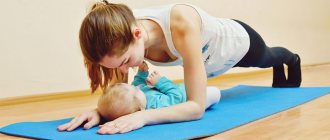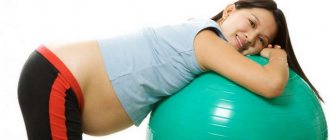How to choose exercises
It's possible to be pregnant and stay constantly on the move. Activity will be equally beneficial for both mother and baby: the baby, while in the womb, thanks to movement, is gently rocked to sleep, and feasible exercises and moderate sports stimulate the blood circulation of the mother in labor, prevent the gain of extra pounds, help strengthen muscles, which leads to relief birth process. Special exercises will help you be in excellent prenatal shape.
How to choose them correctly? The most acceptable option is special courses for pregnant women, where they will correctly select exercises and load strength, taking into account your individual condition. But if there are no courses or you need to go to the other end of the city with several transfers, then it is better to contact the supervising doctor, take into account his recommendations and wishes and start doing the exercises yourself at home.
So, the doctor gave permission to do certain types of exercises. Now you yourself must bring your desires and possibilities into balance. And if during exercise you feel overworked or uncomfortable, don’t overdo it, stop! Your health and the health of your baby is most important. Therefore, exercise extreme caution. Perhaps you need simpler exercises that will bring you pleasure and will be useful for your future child.
Know what to relax
By performing exercises, we learn not only to tense, but also to relax the muscles involved in childbirth. in time , do not squeeze
, not overstraining the muscles while the baby is passing through the birth canal is the key to successful childbirth.
By doing Kegel exercises, it is easy to understand what muscles we use on the baby during childbirth. Therefore, these workouts are a good prevention of perineal ruptures during childbirth. You can easily let go and open the path by learning in advance to tense and relax your muscles. Having a stable skill,
this
during childbirth Everything that has not become a habit will be forgotten. Kegel exercises are also a deep workout of the
pelvic floor muscles; they prevent venous congestion in the pelvis and kidneys. Therefore, they can be used not only by women, but also by men.
Types of Exercise: Tips and Cautions
There are a considerable number of well-thought-out exercises to maintain good physical shape of expectant mothers and facilitate the birth of a new inhabitant of the planet.
The types of physical exercises for pregnant women directly depend on the purpose, permissible load and the specifics of childbirth: in the maternity hospital, in water or vertical.
Let's look at exercises that are easy for most women to do:
- Warm-up exercises.
- Exercises for relaxation.
- Breathing exercises.
- Exercises to strengthen muscles and joint mobility.
- Endurance exercises.
- Exercises that train the muscles of the perineum.
When performing physical exercises, pregnant women must take into account certain rules:
- Perform all exercises at a calm rhythm.
- During the exercise, do not exceed the load: you can damage relaxed joints.
- Exercise for at least fifteen minutes and no more than forty.
- Remember: the best time for classes is from 10.00 to 12.00 and from 18.00 to 19.00.
- Start your classes with a ten-minute warm-up, then devote the same amount of time, five minutes, to heavy and relaxation exercises. After a week, extend each stage of physical activity to fifteen minutes.
- Start your classes with warming up and end with relaxation and breathing.
- Complete your meal one hour before gymnastics so that the calories your child needs can be absorbed.
- During exercise, do not forget to drink water to prevent your body from losing excess fluid.
- Don't hold your breath.
- When performing physical exercises, count out loud: this maneuver will remind you of the importance of proper breathing.
- Conduct classes on a non-slip gymnastics mat.
Additional features - squat
Kegel exercises help develop the pelvic floor muscles, but here, as in any activity, it is important not to overdo it. Remember why we do Kegel exercises before childbirth - to learn how to relax
.
There is an opinion that excessive training of the muscles of the vagina and perineum with weakness of the gluteal muscles can lead to spasms and deviation of the tailbone from its normal position. In other words, tightly contracted muscles cause even greater tension in that area. But fortunately, to prevent tearing and strengthen the pelvic floor, along with Kegel exercises, there is another simple action that will help relax the pelvic floor
.
In earlier times, when a sedentary lifestyle was not so common, a woman’s lifestyle itself contributed to strengthening muscles and preparing for all intimate processes. Natural movements (walking, squats)
in sufficient quantities are the key to harmoniously developed and strong muscles.
All household work in the absence of chairs involves walking and occasional squatting. Moreover, a toilet in the absence of a toilet also involves a “squatting” position. Thus, a deep squat is precisely the exercise that, along with tension of some muscles, gives the necessary stretching and relaxation of others. For example, the muscles involved in childbirth, as well as the normal functioning and blood supply of the pelvic organs. Squatting is a much more natural exercise for the body than it may seem to civilized citizens who are accustomed to squatting no deeper than on a chair.
That's why our program, along with Kegel exercises, encourages you to do deep squats.
For example, squatting while holding the headboard or squatting with a partner is one of the exercises in the Osteopathic Gymnastics Complex
to prepare for childbirth. To perform a squat, join hands with a partner or hold onto the headboard of the bed and squat with a straight back without lifting your heels. In a deep squat, the knees do not go beyond the line of the toes. You can sit down and sway slightly. Rise up in the same way, holding hands with your partner or the headboard of the bed, with your back straight. By incorporating more squatting poses into your life, you will harmoniously complement the effect of Kegel exercises and prepare your muscles for childbirth.
Exercises to help you prepare for childbirth
For training, you have the right to choose one of the complexes with all the exercises or its individual types, relying on your general health, age, and level of training.
More on the topic
What physical exercises will help restore your figure after childbirth?
Abdominal exercises after childbirth
Exercises after caesarean section
How to pump up your abs after childbirth: basic exercises for the abdominal muscles
Kegel exercises for women after childbirth
Aerobics set of physical exercises
- Start your session with a warm-up - walking in place for one minute.
- Starting position: stand with your feet shoulder-width apart, feet parallel to one another, arms extended forward. Start doing half squats, keeping your torso straight. The arms rise and fall simultaneously in rhythm with the squats. Perform the exercise slowly, breathe evenly. Repeat no more than ten times.
- The starting position is the same, only arms to the sides. Leaning your torso forward, touch your hands in turn to the left and right toes of both legs. Breathing should be even, the pace of execution should be average. Repeat twelve times.
- The starting position is the same. Bend your torso slightly, hold your arms loosely at your sides, tilt your head forward, relax the muscles of your arms and upper body. After five seconds, straighten up, moving your shoulders back, bend again. Breathing is uniform, pace is slow. Repeat eight times.
- Starting position: feet slightly wider than shoulder width, arms out to the sides. Leaning forward, turn your body to the right and left, touching the toe of your left foot with your right hand and touching the toe of your right foot with your left hand. After completing ten movements, stand up straight and relax the muscles of your forearm and shoulders. Repeat four times.
- The starting position is the same. Tilt your torso to the right, hold your left hand above your head and your right hand behind your back; tilting your body to the left, hold your right hand above your head and your left hand behind your back. Repeat the exercise twelve times at an average pace.
- Starting position: stand straight, keep your legs together, lower your arms along your body. Tilt your body to the right and left. Accompany the tilts by sliding your hands: slide your right hand down and your left hand up when tilting to the right; Slide down with your left hand and up with your right, leaning to the left. Perform the exercise no more than twelve times without holding your breath.
After completing the set of exercises, take about ten deep breaths through your nose and exhale through your mouth.
Eight exercises to solve three important problems
Prevention of complications during pregnancy.
The body, rebuilt to bear a child, changes significantly.
The mammary glands become larger and heavier, pulling the shoulders forward, which shortens the chest muscles and lengthens the back muscles. Pain appears in the back, neck, and shoulder girdle. The joint ligaments relax, the abdomen enlarges, balance is disturbed, and the woman can easily stumble and even fall. If your back muscles are trained, it is much easier to resist this. In addition, the more a woman strengthens her chest and back muscles during pregnancy, the easier it will be for her to lift and carry a baby in the future. Preparing for the difficult task of helping the body at the moment of expulsion of the fetus.
At this stage, the main load falls on the internal muscles of the abdomen, pelvis and hips.
Often women feel exhausted during the birth process because their legs are tired. Relaxation is a very important point:
in order to gain strength for the next contraction or a new period of labor, a woman must be able to completely relax and calm her body.
1. Gaining strength for pushing
Imagine that as you exhale, your navel “rides the elevator” along the spine. “Pull” it with effort, as if trying to climb, for example, to the fifth floor. Press your back tightly to the floor. Perform the exercise 10 times in a row, 5 times a day. Gives strength for the upcoming birth and facilitates postpartum contraction of the uterus to its previous size.
2. Help stretch muscles
As described in the first exercise, “we go to the fifth floor.” Then we begin the descent. On the fourth we stop, count to 30, and return to the first floor. And so 10 times. Next exercise: starting to move up, we get stuck on the second floor for 30 seconds, then we get to the fourth, stop, descend. Repeat 25 times. Perform the exercise 5 times a day.
3. Unload the spine
Place your hands with a towel behind your head, elbows below shoulder level. Stay in this position for 30 seconds. Repeat several times. Relieves pain in the chest and back.
4. Get saturated with oxygen
You can sit relaxed on a chair, kneel, or do the exercise while standing. Breathe deeply - as if your lungs are located below, in your stomach. As you inhale, stick your stomach out, and as you exhale, draw it in. Do this exercise for 10 minutes. Important: exhale completely every time!
5. Facilitate the process of future childbirth
Very slowly, from a standing position, squat down with your feet as firmly on the floor as possible. To begin, hold for 15-20 seconds. Over time, build up to staying in this pose for up to a minute. Exercise strengthens the abdominal cavity, abdomen and pelvic area and promotes rapid opening of the uterine os during contractions.
6. Making muscles elastic
Sit on the floor. One leg is bent at the knee, the other is extended. Use an elastic band (or just a long towel) to help. Lean your body forward, stay in this position for 20 seconds, straighten up, repeat 5 times. The exercise promotes mobility of the knee and hip joints.
7. Reduce back pain
Imagine that your tailbone is “tied” to an elastic band, and you are making an effort, resisting it, in the following three exercises:
- Hold the imaginary resistance for 5 seconds in a standing position (leaning forward slightly) - repeat 10 times.
- Hands on knees, body forward.
- Standing on all fours, rock your pelvis back and forth (while “holding” the band with effort).
8. Train endurance
Lie on your back with your buttocks against the wall, step your legs up the wall, then spread your legs as wide as you can, hold this for 30 seconds. The exercise stretches the muscles, the legs will now be able to withstand a greater load.
Lying on your back, do two pelvic floor exercises: squeeze your vaginal muscles and hold for up to 10 seconds. And one more thing: imagine an “elevator ride” in the direction from the vagina to the navel, slowly return back. Repeat 5 times.
Kegel complex: essence and purpose
Imbuilding, intimate gymnastics - the so-called Kegel exercises - are not just a series of special exercises, but an entire training system, which is named after its creator - the American obstetrician-gynecologist A. Kegel. In general, the set of exercises was developed not only for pregnant women, and is intended to activate and strengthen the pelvic muscles.
The muscles being developed are located between the pubic bone and the coccyx, and perform tasks that are significant for the normal functioning of the body:
- support the pelvic organs;
- regulate the processes of normal excretion of urine and feces;
- thanks to the connection with the abdominal and back muscles, they promote correct posture;
- influence sexual well-being and achievement of pleasure.
These muscles are elastic, flexible and work involuntarily. If they lose their tone and stretch too much, this can lead to a number of problems:
- involuntary urination and/or defecation;
- haemorrhoids;
- constipation;
- inflammatory processes of the reproductive system;
- pelvic organ prolapse;
- decreased sexual sensitivity;
- pelvic pain;
- discomfort during sexual intercourse.
When the first symptoms of such problems appear, you should not panic, since the pelvic floor muscles are easy to train, and strengthening them eliminates problems.
In addition, intimate gymnastics has a positive effect on the female body:
- smooth out the primary signs of menopause;
- increase intimate sensitivity;
- help you be more likely to achieve orgasm;
- prevent uterine prolapse;
- facilitate childbirth;
- speed up the process of postpartum recovery.
Kegel exercises for pregnant women are of particular importance, so it is worth studying them from this “perspective” in more detail.
How and how does physical activity help prepare?
Experts recommend performing a special set of exercises throughout pregnancy. What's the benefit?
- Gymnastic exercises develop mobility and flexibility of the pelvic bones and lower spine, which will greatly facilitate childbirth and reduce pain in the lower back during the birth of the baby.
- The thigh muscles are stretched so that the woman in labor can be comfortable in the maternity chair for as long as needed.
- They maintain the tone of the pelvic and vaginal muscles in order to avoid such troubles as urinary incontinence and hemorrhoids after childbirth, as well as shorten the recovery period.
- Helps the cervix to open in a timely manner.
Contraindications
- Previous miscarriages, or a diagnosis of “threat of premature birth” has been made.
- Placenta previa or low location.
- Bleeding from the genital tract.
- Hypertension.
- Severe toxicosis in the early stages.
- Preeclampsia.
- Pain in the lower abdomen.
- Multiple pregnancy.
Note! During gymnastics, the expectant mother should monitor her condition very carefully.
If during or after exercise you experience symptoms such as pain in the lower abdomen, strange discharge, dizziness, increased heart rate over 130 beats per minute, increased blood pressure to more than 140/100 mm Hg, difficulty breathing or pain in the heart - You should stop exercising immediately and seek medical attention.
Fitball exercises
Fitball for expectant mothers has no contraindications, and you can use it at any stage of pregnancy.
The expectant mother can exercise lying on a ball, which will strengthen her back and abdominal muscles, sitting to strengthen the pelvis, or lying on a fitball and standing on all fours, which will reduce the load on the spine and eliminate back pain.
Exercises:
- sit on the ball, lean your hands on it, maintaining your balance. Later this can be done without hands. Start rotating and rocking your pelvis back and forth;
- sit on the floor, spread your legs wider and grab the ball, then begin to squeeze it as tightly as possible. Do this until you feel tired;
- sit on the fitball, spread your knees, and reach with your hands to each foot in turn;
- Also, while in a sitting position, turn your body to the left and then to the right.
Why and when is it necessary to prepare the body to give birth?
Scientists have long proven the positive effects of gymnastics for pregnant women . Also, the benefits have been confirmed by many years of practice. Thanks to morning exercises, a pregnant woman receives the necessary surge of strength and energy, as well as a great mood.
Moreover, it is not necessary to exercise only in the morning. Physical exercises can be performed at any convenient time. Special complexes include exercises that involve the muscles of the back, legs and abdomen. Breathing exercises, exercises with a ball, swimming and walking are also useful.
Sets of exercises for pregnant women are developed under the guidance of obstetricians and gynecologists, and are allowed to be performed only by healthy women - those whose gestation proceeds without complications.
In the absence of contraindications, regular gymnastics will gradually prepare the expectant mother’s body for the upcoming birth .
Important! Women who do exercises during pregnancy get in shape faster after childbirth, and the birth itself is much easier for them.
Below is a useful video about why gymnastics is needed for pregnant women:
Gymnastics for breech presentation
A set of exercises to ensure that the baby turns over must be performed from the 32nd week of pregnancy.
- Lie on the side where the baby's head is displaced and lie in this position for 3-10 minutes. Lie on the other side for the same amount of time. The exercise should be done 2-3 times a day. It is also better to sleep on the side where the baby's head is displaced.
- In order for the fetus to eventually turn over, you need to lie on your back, placing something under the lower back, so that the pelvis is approximately 20-30 cm above the head. You need to lie in this position for 5–15 minutes. The exercise should be performed twice a day.
- Swimming in the pool. Swimming in the pool can be very useful for breech presentation.
When are Kegel exercises contraindicated?
No matter how useful, simple and effective intimate gymnastics exercises for pregnant women are, there are a number of restrictions and contraindications to their implementation:
- threat of pregnancy failure;
- any manifestations of severe toxicosis or gestosis;
- bloody discharge from the uterine cavity;
- fever;
- unpleasant or painful sensations when performing exercises.
Restrictions can be temporary or permanent, concern the complex as a whole or individual exercises. Only a doctor can determine the degree of danger and the possibility of performing classes according to the system in the future.










